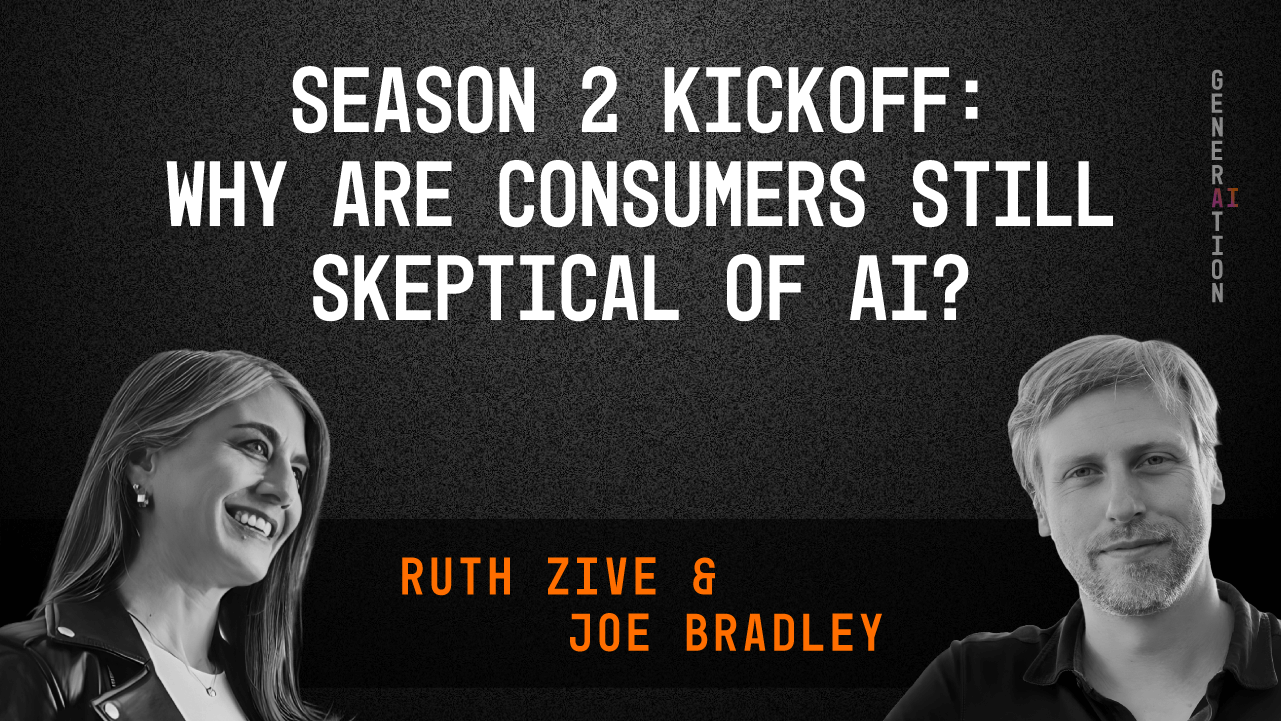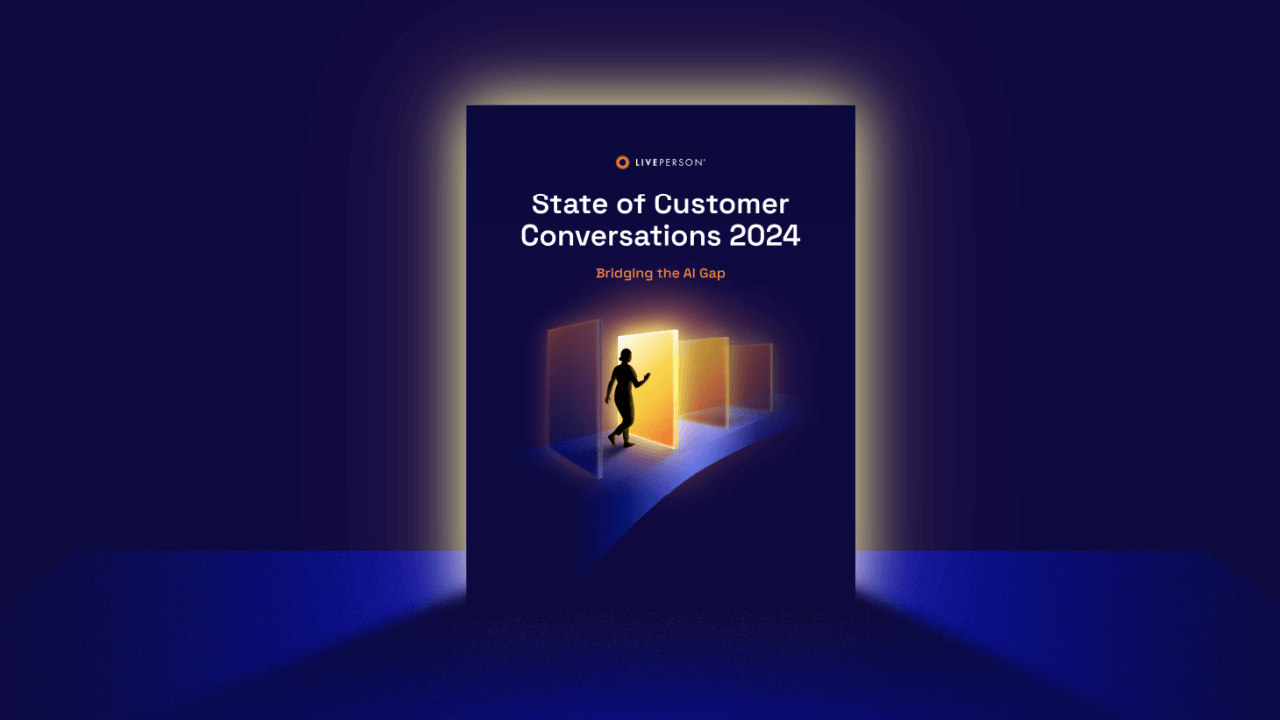PODCAST OVERVIEW
Trust in AI: Why are consumers still skeptical?
February 29, 2024 • 5 minutes

To kick off the sophomore season of our Generation AI podcast, co-hosts Ruth Zive, CMO, and Joe Bradley, Chief Scientist, at LivePerson break down the emerging “AI Gap” between businesses and customers. They dive into why customers are skeptical of artificial intelligence systems, how certain demographics feel toward AI and automation, and strategies for closing the gap between businesses and their customers.
LivePerson’s State of Customer Conversations 2024 report reveals “AI Gap”
LivePerson recently put out a report based on survey data gathered from thousands of consumers and business leaders, which sheds light on their true feelings about customer-facing artificial intelligence.

“The main finding of the report is that there’s an AI gap brewing. Business leaders are surprisingly all in — eager to roll out this technology and put it to good use. On the flip side, consumers are actually quite skeptical,” says Ruth.
In fact, 91% of business leaders reported feeling positive about using AI systems in order to engage with their customers, but only 50% of consumers agree.
Why is there such a large gap?
It’s possible some of the differences between business and consumer opinions are a result of a “hype hangover” from last year’s release of ChatGPT with business leaders coming on stronger because they see AI implementation as a cost-saving opportunity.
Saving money certainly drives enthusiasm; however, it is worth noting that the attitude surrounding AI has been progressing for some time.
“If you think back to the attitude towards AI and chatbots in 2021, you’d remember a large percentage of folks that really believed AI technology was nowhere near useful, so that explains the 50% who hesitate,” says Joe.
The 91% of business leaders who are excited to use AI is a more idealistic number resulting from an underlying current of leaders who are catching on and recognizing that AI technologies are almost there.
“However, when I work with businesses that are about to turn AI on for their customers, they start to get scared of this gap. All of a sudden, they worry about hallucinations in the AI system, mistakes it might make, or ways that it can be abused by users,” Joe says.
Some of the excitement and sureness from business leaders appear to fall off as they approach the implementation of customer-facing AI models.
On both sides, we see worries about the consequences of potential negative experiences with AI fails and the legal and regulatory ramifications that result because that is such a gray area right now.
“Customers especially have concerns on the receiving end of this technology because a lot of them are battle-scarred from prior experiences with chatbots that have not been positive, leading to leftover skepticism or cynicism,” Ruth says.
Over half of business leaders report increased investment in AI messaging systems
“Unlike what we’ve seen in the past, just over half of business leaders say they’re prioritizing messaging with AI over traditional customer service channels, like phone or email,” says Ruth.
As far back as six years ago, teams at LivePerson started to see that messaging channels were the future of customer service based on the way people like to communicate with each other personally.
As consumer demographics continue to change, we will continue to see a shift in how customer service is done. The newer generation of customers who are really only accustomed to using messaging channels is emerging.
“I think about my own kids who range in age from 19 to 31, and they would rather message than pick up a phone — there is no universe in which they would choose calling. But my parents or my in-laws would never message,” says Ruth.
Some of this change will happen organically as the older population ages and the younger population becomes the real buyers and decision-makers. Still, the push from business leaders to focus on AI messaging systems will surely drive this change to fruition faster.
“It makes sense when you look at how people were introduced to the large language models last year through ChatGPT and the chat interface there. It also makes sense when you think about the modality of communication itself,” says Joe.
With messaging, consumers don’t have the same expectations for response time that they have in a voice context.
Waiting five seconds for someone to respond to something that you said in a conversation can be an awkward and difficult experience, whereas having to wait five seconds for someone to text back is pretty normal—in fact, that’s kind of fast.
Building trust in AI: Bridging the gap between businesses and consumers
To effectively bridge the AI gap, business leaders need to think of the AI application as a kind of product, whether it’s an internal-facing product or an external-facing product, and treat it with the same discipline as such.
A tool or platform using artificial intelligence doesn’t make it magic and doesn’t make it immune to being a tool — it just feels that way because AI feels kind of human to us.
“One whole class of problems is not thinking of AI like a product or a business and failing to apply the same basic tools that one would apply to rolling anything out by validating it and making sure that it adds value to the technology,” says Joe.
Failure to treat an AI model like a product or tool leads to broken trust as a result of previously mentioned hallucinations, mistakes, or potential user abuse.
“Leaders should always want to roll new AI applications out in a way that’s going to continue to validate that the customer is getting what they need without compromising their trust or loyalty to cut costs. That’s ultimately how you bridge the gap,” says Ruth.

